NEW
| Reijs'
results |
Kolev's
observations [2001] |
||||||||||
| Location |
Object |
Heliacal event |
Date |
First time UT [hh:mm] |
Time visible [min] |
Topo ARCV (opt) [o] |
AECRK**** [-] |
First time UT [hh:mm] |
Time visible [min] |
AV [o] |
Visibility |
| Varna
Tashla, BG |
Procyon | morning first/heli. rise | 2000/8/15 |
2:18 | 13 | 14.3 | 0.25 |
2:19 | 13 | 13.8* |
good |
| Varna Tashla, BG |
Procyon | morning first/heli. rise | 2000/8/16 |
2:25 | 3 | 15.7 | 0.33 |
2:21 | 3 | ??? |
bad |
| Varna
Tashla, BG |
Sirius | morning first/heli. rise | 2000/8/17 |
2:38 | 12 | 10.8 | 0.29 |
2:32 | 12 | 10.7 |
bad |
| Varna, BG |
Procyon | morning first/heli. rise | 2000/8/18 |
2:26 | 2 | 17.6 | 0.43 |
2:33 | ??? | ??? |
bad |
| Varna, BG |
Sirius | morning first/heli. rise | 2000/8/19 |
2:32 | 24 | 12.5 | 0.36 |
2:32 | 25 | 12.5 |
average |
| Reijs'
results |
Kolev's
observations [2007] |
||||||||||
| Location |
Object |
Heliacal event |
Date |
First time UT [hh:mm] |
Time visible [min] |
Topo ARCV (opt) [o] |
AECRK**** [-] |
First time UT [hh:mm] |
Time visible [min] |
AV [o] |
AECRK**** [-] |
| Varna, BG |
Sirius | evening last/heli. set |
2000/5/10 |
17:45 |
16 |
12.6 |
0.40 |
17:45 | ??? |
12.0 |
0.42 |
| Varna, BG |
Sirius | morning first/heli. rise | 2000/8/17 |
2:38 | 12 |
10.9 | 0.30 |
2:32 | 12 |
10.8 |
0.36 |
| Rila, BG | Sirius | morning first/heli. rise | 2004/8/16 |
2:57 | 13 | 10.9 | 0.29 |
3.04 |
13 | 10.8 |
??? |
| Varna, BG |
Sirius | morning first/heli. rise | 2006/8/19 |
2:33 | 23 | 12.1 | 0.33 |
2.24** |
28 |
12.0 |
0.42 |
| Seattle, USA |
Sirius | morning first/heli. rise | 2003/8/19 |
12:28 |
15 |
8.2 |
0.16 |
12:28 |
16 |
8.2 |
0.16 |
| Seattle, USA |
Sirius | morning first/heli. rise | 2005/8/19 | 12:29 |
17 |
8.6 |
0.17 |
12:30 |
17 |
8.6 |
0.20 |
| Reijs' results |
Kolev's observations [2006] | |||
| Observation |
Location |
Event |
AEC**** | Visibility |
| 1 |
Seattle, USA |
morning first |
0.22 |
clear |
| 2 |
Seattle, USA | morning last |
0.19 |
clouds
(clear
before/after) |
| 3 |
Seattle, USA | evening last |
0.25 |
clouds (clear before/after) |
| 4 |
Varna, BG |
morning first | 0.21 |
very
clear*** |
| 5 |
Varna, BG | morning last | 0.21 |
very clear |
| 6 |
Varna, BG | morning last | 0.20 |
very clear |
| 7 |
Varna, BG | evening last |
0.29 |
fair
clear |
| 8 |
Varna, BG | evening last |
0.19 |
clouds? (clear before/after) |
| Criterion |
Year published |
Valid locations |
Parameter set |
Best Time |
Number of categories |
Method |
Derived from |
| Fotheringham |
1910 |
Greece |
(GeoARCV,
DAZ) |
GeoAltS@0 | 2 |
Emp. |
|
| Maunder |
1911 |
Greece + West Europe |
(GeoARCV, DAZ) | GeoAltS@0 | 2 |
Emp. |
|
| Schoch |
1927 |
Babylon | (GeoARCV, DAZ) | GeoAltS@0 | 2 |
Emp. |
|
| Neugebauer |
1929 |
Babylon |
(GeoARCV, DAZ) | GeoAltS@0 | 2 |
Emp. |
Schoch |
| Indian |
1966 |
Babylon | (GeoARCV, DAZ) | GeoAltS@0 | 2 |
Emp. |
Neugebauer |
| Bruin |
1977 |
Babylon | (GeoARCV, GeoW) | GeoAltS@0 | 2 |
Theo. |
|
| Yallop |
1998 |
Many | (GeoARCV, TopoW) | (TopoAltM@0*4+TopoAltS@0*5)/9 | 7 q-values |
Emp. |
Indian, Bruin |
| Caldwell&Laney |
2001 |
Many |
(AppARCL/3+AppARCV, DAZ) | AppAltS@0 | 3 |
Emp. |
|
| Moonsighting |
2002 |
Many |
(GeoARCV, TopoW) | (GeoAltM@0*4+GeoAltS@0*5)/9 | 7 q-values | Emp. |
Yallop, different q-values |
| Odeh |
2004 |
Many |
Topocentric |
(TopoAltM@TopoDip*4+TopoAltS@TopoDip*5)/9 | 4 |
Emp. |
Yallop |
| Hoffman |
2005 |
Many |
(AppAltM-TopoAltS,
TopoW) |
(TopoAltM@0*6+TopoAltS@0*4)/10 | 4 |
Emp. |
Yallop |
| Reijs |
2007 |
Many |
(Geo/TopoARCV,
DAZ/TopoW) |
TopoAltM@Maximum
contrast |
2 |
Theo. |
Schaefer |
| Qureshi |
2010 |
Many |
(GeoARCV, TopoW) | (GeoAltM@0*4.3+GeoAltS@0*5)/9.3 | 6
s-values |
Theo. |
Odeh, Yallop, Schaefer |
| Yallop [1998, page 12] |
Moonsighting (pers. comm. K. Shaukat, [2011]) |
Qureshi [2010, page 16] |
||||||
| Category |
Description | q-values |
Category |
Description |
q-values |
Category |
Description |
s-values |
| A |
Easily visible, ARCL
>= 12 |
q>=0.216 |
A |
Easily visible to the naked eye | q>=0.27 |
EV |
Easily visible |
s>=0.15 |
| B |
Visible under perfect conditions | 0.216>q>=-0.014 | B |
Visible to the naked eye under perfect atmospheric conditions | 0.27>q>=-0.024 |
VUPC |
Visible under perfect
conditions |
0.15>s>=0.05 |
| C |
May need optical aid to find the crescent | -0.014>q>=-0.16 | C |
May need optical aid to find the crescent before it can be seen with naked eye | -0.024>q>=-0.212 |
MROA |
May require optical
aid to find crescent |
0.05>s>=-0.06 |
| D |
Will need optical aid
to find crescent |
-0.16>q>=-0.232 | D |
Can only be seen with binoculars or a (small) conventional telescope | -0.212>q>=-0.48 | ROA |
Require optical aid |
-0.06>s>=-0.16 |
| E |
Not visible with a telescope, ARCL <= 8.5 | -0.232>q>=-0.293 | E |
Below the normal limit of detection with a (small) conventional telescope | -0.48>q>=-0.523 | |||
| F |
Not visible below
Danjon limit, ARCL <= 8 |
q<-0.293 | F |
Not visible with even large observatory type telescopes | q<-0.523 |
I |
Not visible with optical aid | s<-0.16 |
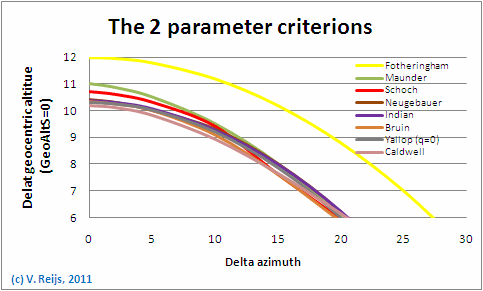
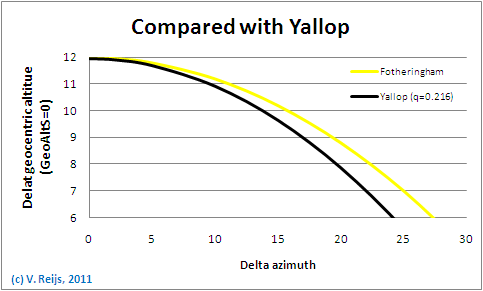
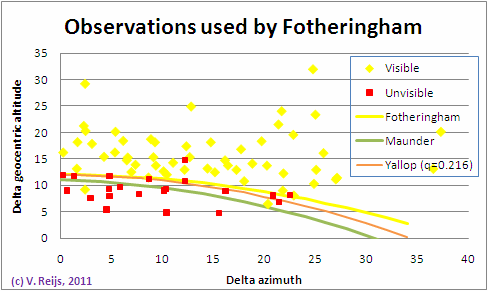


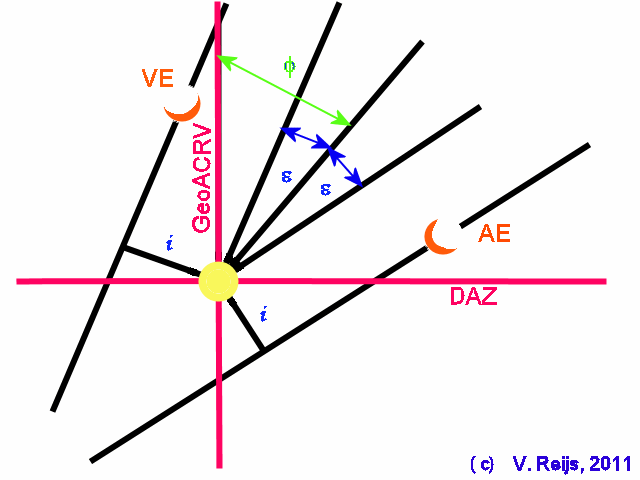
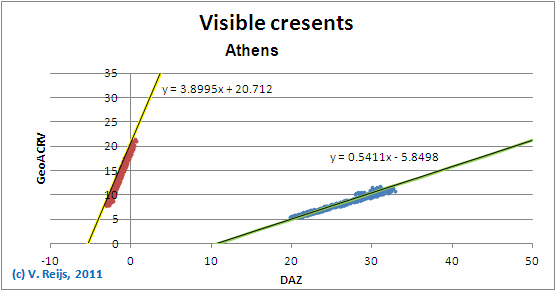
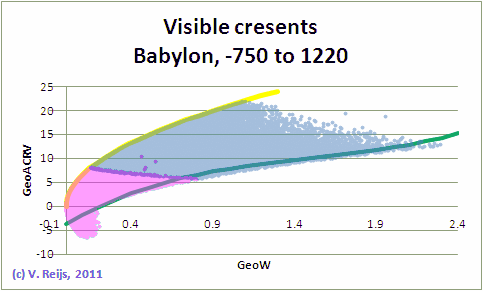
| Process |
Main
parameters |
| Astronomical
Extinction coefficient (AEC) |
Geographic (Eye
Height, Latitude), Meteorological (Relative
Humidity,Temperature), Season (Sun's Right
Ascension) |
| Airmass
between object/sky and observer |
Viewing object's
altitude (AltM), AEC |
| Object's
brightness at observer |
Object's Magnitude
(Distance Object-Sun, Distance Object-Earth,
Object's Phase angle [ARCL]), Airmass |
| Sky's brightness at observer | Sun's Magnitude, Sun-Object angle (ARCL), Airmass |

| Actually observed (positive obs.) |
Actually not observed (negative obs.) |
|
| correct (true)
postdiction |
X |
Y |
| incorrect (false) postdiction | P
(Type
I error) |
Q
(Type
II error) |
I would like to thank the following people for
their help and constructive feedback: Roy Hoffman,
Dieter Koch, Rumen Kolev, Rolf
Krauss, Khalid Shaukat and
all other unmentioned people. Any remaining errors in
methodology or results are my responsibility of
course!!! If you want to provide constructive feedback,
let me know.